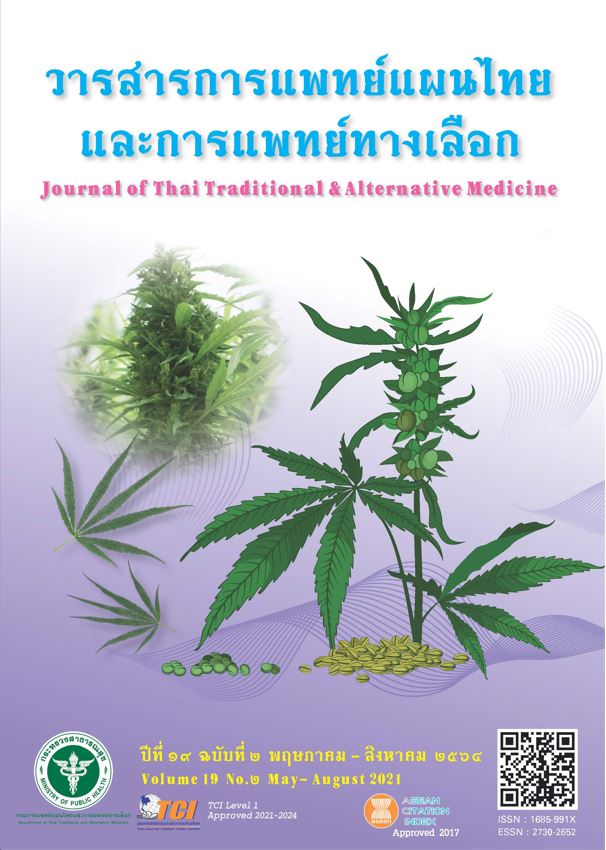Benefit and Safety of Suk Sai-Yad Traditional Medicine Recipe in Patients with Insomnia
Main Article Content
Abstract
“Suk Sai-Yad” is the fourty-fourth traditional medicine recipe recorded in “the Royal Scripture of King
Narai’s Medicines”. This recipe contains 78 parts of 12 herbal ingredients, of which 12 parts are cannabis leaves as the main ingredient. Suk Sai-Yad was used as a panacea, analeptic, tonic, and sedative hypnotic. The objective of this study is aimed to evaluate the efficacy and safety of Suk Sai-Yad Recipe in OPD patients with insomnia who visited Hang-Ka-Rok medical cannabis clinic in Phra Arjarn Fhan Arjaro Hospital. This study is a prospective observational study conducted during June-December 2020 in 60 outpatients who were presented and diagnosed with insomnia, by a medical doctor and a Thai traditional medicine doctor, and were prescribed Suk Sai-Yad remedy for their treatment. The patients received Suk Sai-Yad powder (2 g) in aluminum foil packets to be taken by suspending ½-1 packet in water first or by mixing with a small amount of honey and taking as pill(s), once at bedtime for 4 weeks. Before taking the prescribed medication and on days 7, 14, 21, and 28 of the treatment, the insomnia condition, sleep quality, quality of life and health state of the patients were determined upon follow-ups using Thai version of the Pittsburgh Sleep Quality Index (T-PSQI) and EQ-5D-5L questionnaire, and any adverse drug reactions occurred after taking medication were recorded. It was found that 96.67% of the patients had improved insomnia condition after taking Suk Sai-Yad for 3-4 weeks. The average Pittsburgh Sleep Quality Index (PSQI) global score after taking Suk Sai-Yad (6.47 ± 1.90) was significantly lower than that before the treatment (14.13 ± 2.29) (p < 0.05). The top three PSQI component scores that decreased the most were 1) component 2 - sleep latency, 2) component 3 - sleep duration, and 3) component 4 – habitual sleep efficiency. The five dimensions (5D) quality of life and health state mean scores of the study group before taking the medicine were 0.821 ± 0.19 and 83.43 ± 14.07, respectively. After receiving four-week Suk Sai-Yad remedy, the 5D quality of life and health state mean scores significantly increased to 0.903 ± 0.11 (p = 0.036) and 89.27 ± 11.45 (p = 0.028), respectively. Three most commonly found non-serious adverse drug reactions were heartburn (21.67%), dizziness (5%) and dry mouth and throat (5%). In conclusion, the study showed that Suk Sai-Yad traditional medicine remedy at the dosage regimen used in this study was effective and safe to solve insomnia problem and helped improve the quality of life and health state of insomnia patients.
Article Details
References
Closs SJ. Sleep. In: Alexander MF, Faweett JN, Runciman PJ, editors. Nursing practice: Hospital and home
– The adult. Edinburgh: Churchill Livingstone; 1999. p.743-56.
Ben DT, Lee TJ. Sleep duration, subjective sleep disturbance and associated factors among university students
in Korea. J Korea Med Sci. 2001;16:475-80.
Rodriguez JC, Dzierzewski JM, Alessi CA. Sleep Problem in the Elderly. Med Clin North Am. 2015;99(2):431-9.
Kryger M, Roth T, Dement WC. Principles and practice of sleep medicine. 6th ed. Philadelphia: Wolters Kluwer;
Razali R, Ariffin J, Puteh SEW, Wahab S, Daud TIM. Sleep quality and psychosocial correlates among elderly
attendees of an urban primary care centre in Malaysia. Neurology Asia. 2016;21(3):265-73.
Protection of Thai Traditional Knowledge Office, Department of Thai Traditional and Alternative Medicine.
Osoth Somdej Phar Narai Textbook. Bangkok: The War Veterans Organization of Thailand under Royal Patronage
of His Majesty the King; 2000. (in Thai)
Touw M. The religious and medicinal uses of cannabis in China, India and Tibet. J Psychoactive Drugs.
;13(1):23-34.
Narcotics Act (Number 7) B.E. 2562. Published in Government Gazette, Vol. 136. Part 19 Kor. (2019 Feb 18).
(in Thai)
Sarfaraz S, Najam R, Sarfaraz A. CNS depressant, sedative and anxiolytic activity of ethanolic extract of fruit
of Piper chaba revealed after neuropharmacological screening. Int J Pharm Pharm Sci. 2014;6(11):186-9.
Faculty of Pharmaceutical Science, Ubonratchathani University. Herbal database. [Internet]. 2010 [cited 2021
Apr 17]; Available from: http://www.phargarden.com
Sonavane GS, Sarveiya VP, Kasture VS, Kasture SB. Anxiogenic activity of Myristica fragrans seeds. Pharmacol
Biochem Behav. 2002;71(1-2):239-44.
Wade DT, Makela P, Robson P, House H, Bateman C. Do cannabis-based medicinal extracts have general or
specific effects on symptoms in multiple sclerosis? A double-blind, randomized, placebo-controlled study on
patients. Mult Scler. 2004;10(4):434-41.
Vaney C, Heinzel-Gutenbrunner M, Jobin P, Tshopp F, Gattlen B, Hagen U, Schnelle M, Reif M. Efficacy,
safety and tolerability of an orally administered cannabis extract in the treatment of spasticity in patient with
multiple sclerosis: a randomized, double-blind, placebocontrolled, crossover study. Mult Scler. 2004;10(4):417-24.
Linck VM, da Silva AL, Figueiró M, Caramão EB, Moreno PR, Elisabetsky E. Effects of inhaled linalool in anxiety,
social interaction and aggressive behavior in mice. Phytomedicine. 2010;17(8-9):679-83.
Deesamer S, Terathongkum S. Quality of sleep in person with cancer. Rama Nurse J. 2010;16(1):27-39.
Shneerson JM. Sleep medicine: A guide to sleep and its disorders. 2nd ed. Malden, MA: Blackwell; 2005.


